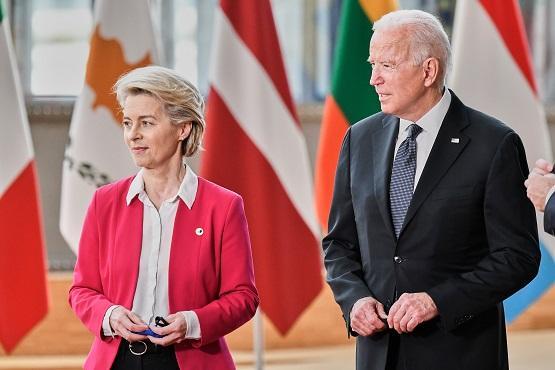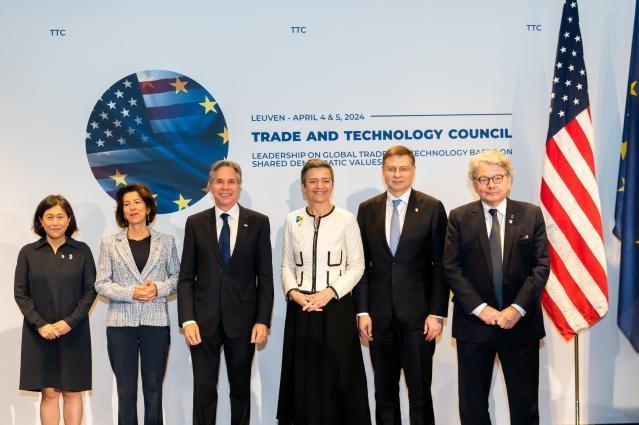Unia Europejska i Stany Zjednoczone są zdecydowane przyśpieszyć transformację cyfrową i zacieśnić partnerską współpracę w dziedzinie nowych technologii opartą na wspólnych wartościach demokratycznych, w tym poszanowaniu praw człowieka.
Rada UE–USA ds. Handlu i Technologii umożliwia Stanom Zjednoczonym i Unii Europejskiej koordynowanie podejścia w najważniejszych kwestiach o wymiarze światowym w obszarze handlu, gospodarki i technologii. Rada pozwala również zacieśnić współpracę handlową i gospodarczą w oparciu o wspólne wartości. Powołano ją do życia podczas szczytu UE-USA, który odbył się w Brukseli 15 czerwca 2021 r.

Cele partnerstwa
Za pośrednictwem Rady UE i USA wspólnie dążą do tego, by:
- handel i technologia służyły naszym społeczeństwom i gospodarkom przy poszanowaniu wspólnych wartości
- wzmocnić wiodącą pozycję w przemyśle i w dziedzinie technologii
- rozszerzyć dwustronny handel i inwestycje.

Rozmowy między UE i USA odbyły się w Leuven (Belgia) w dniach 4–5 kwietnia 2024 r., podczas szóstego posiedzenia ministerialnego Rady UE–USA ds. Handlu i Technologii. Osiągnięto porozumienie w następujących kwestiach:
1. Zacieśnianie współpracy transatlantyckiej w dziedzinie sztucznej inteligencji, 6G, technologii krytycznych i nowych technologii
- Sztuczna inteligencja (AI): potwierdzono zaangażowanie na rzecz podejścia do AI opartego na analizie ryzyka oraz na rzecz wspierania bezpiecznych i wiarygodnych technologii AI, które pomogą znaleźć rozwiązania globalnych problemów; zapowiedziano nowy dialog między Europejskim Urzędem ds. AI a amerykańskim Instytutem ds. Bezpieczeństwa AI
- 6G: przyjęto wspólną wizję 6G określającą najważniejsze zasady dla tej technologii i podpisano porozumienie administracyjne dotyczące współpracy badawczej
- Półprzewodniki: przedłużono o trzy lata dwa porozumienia administracyjne, które umożliwiają budowanie odpornych łańcuchów dostaw półprzewodników
- Standardy dla nowych technologii: opublikowano sprawozdanie dotyczące mapowania tożsamości cyfrowej służące zbadaniu potencjału interoperacyjności amerykańsko-europejskiej i transgranicznego korzystania z tożsamości cyfrowych
2. Promowanie łatwiejszego, bardziej zrównoważonego i bezpieczniejszego handlu na rynku transatlantyckim
- Zrównoważony handel: potwierdzono znaczenie transatlantyckiej inicjatywy na rzecz zrównoważonego handlu i uzgodniono publikację wspólnego katalogu najlepszych praktyk w zakresie zielonych zamówień publicznych, aby przyspieszyć wdrażanie projektów w zakresie zrównoważonego rozwoju finansowanych ze środków publicznych
- Łatwiejszy handel: uzgodniono ułatwienie stosowania narzędzi cyfrowych w handlu, a także skoordynowanie i ujednolicenie standardów technicznych dotyczących systemów fakturowania elektronicznego
- Czysta energia: z zadowoleniem przyjęto publikację zaleceń dotyczących większej kompatybilności amerykańskiej i europejskiej infrastruktury ładowania pojazdów elektrycznych
- Minerały krytyczne: osiągnięto postęp w negocjacjach dotyczących umowy w sprawie minerałów krytycznych, która ma wzmocnić transatlantyckie łańcuchy dostaw minerałów krytycznych do baterii do pojazdów elektrycznych i z zadowoleniem przyjęto utworzenie forum partnerstwa na rzecz bezpieczeństwa surowców mineralnych
- Bezpieczeństwo gospodarcze: po raz kolejny wyrażono wspólne obawy dotyczące wyzwań związanych z wymuszeniem ekonomicznym i praktykami nierynkowymi stosowanymi przez państwa trzecie, a także zdecydowano się kontynuować działania na rzecz zmniejszenia ryzyka i dywersyfikacji stosunków handlowych i inwestycyjnych oraz ułatwienia bezpiecznego handlu w dziedzinie zaawansowanych technologii
3. Ochrona praw człowieka i wartości w zmieniającym się geopolitycznie środowisku cyfrowym
- Przemoc ze względu na płeć: opracowano zestaw wspólnych zasad przeciwdziałania przemocy ze względu na płeć na platformach internetowych
- Demokracja i prawa człowieka: potwierdzono poparcie dla demokracji na całym świecie oraz dla zwalczania zagranicznych manipulacji informacjami i ingerencji w informacje, a także opublikowano wspólne zalecenia dla platform internetowych na rzecz ochrony obrońców praw człowieka w internecie
- Dane: zobowiązano się do ułatwienia dostępu do danych z platform internetowych i opublikowano sprawozdanie na temat mechanizmów umożliwiających naukowcom dostęp do takich danych
Wspólne oświadczenie Rady UE–USA ds. Handlu i Technologii (5 kwietnia 2024 r.)
Obszary współpracy
Na pierwszym posiedzeniu, które odbyło się 29 września 2021 r. w Pittsburghu (Stany Zjednoczone), Rada uzgodniła pięć kluczowych obszarów współpracy:
- kontrola eksportu
- monitorowanie bezpośrednich inwestycji zagranicznych
- bezpieczne łańcuchy dostaw (zwłaszcza półprzewodników)
- normy technologiczne, w tym współpraca nad sztuczną inteligencją
- wyzwania dla handlu światowego.
Organizacja prac
Rada składa się z grup roboczych, którymi kierują lub współkierują odpowiednie departamenty, służby lub agencje. Zadaniem grup roboczych jest przełożenie decyzji politycznych na konkretne działania i koordynacja prac technicznych.
W skład rady wchodziło początkowo 10 grup roboczych zajmujących się następującymi tematami:
| 1. Współpraca w zakresie norm technologicznych |
| 2. Klimat i czyste technologie |
| 3. Bezpieczne łańcuchy dostaw |
| 4. Bezpieczeństwo i konkurencyjność ICT |
| 5. Zarządzanie danymi i platformy technologiczne |
| 6. Niewłaściwe użycie technologii zagrażające bezpieczeństwu i prawom człowieka |
| 7. Współpraca w zakresie kontroli eksportu |
| 8. Współpraca w zakresie monitorowania inwestycji |
| 9. Wspieranie MŚP w uzyskaniu dostępu do technologii cyfrowych i szerszym ich wykorzystaniu |
| 10. Wyzwania dla handlu światowego |
Kontekst
Przewodnicząca Komisji Europejskiej Ursula von der Leyen i prezydent Stanów Zjednoczonych Joe Biden powołali do życia Radę UE–USA ds. Handlu i Technologii 15 czerwca 2021 r., na szczycie UE–USA w Brukseli.
Rada spotyka się okresowo na szczeblu politycznym, aby nadać kierunek współpracy. Jej pracom współprzewodniczą po stronie UE: Margrethe Vestager, wiceprzewodnicząca wykonawcza Komisji Europejskiej i komisarz UE ds. konkurencji, oraz Valdis Dombrovskis, wiceprzewodniczący wykonawczy Komisji Europejskiej i komisarz UE ds. handlu. Po stronie Stanów Zjednoczonych są to natomiast: sekretarz stanu USA Antony Blinken, sekretarz handlu USA Gina Raimondo oraz przedstawiciel USA ds. handlu Katherine Tai.
Równolegle UE i USA ustanowiły wspólny dialog na temat polityki konkurencji w dziedzinie technologii, który będzie dotyczyć przede wszystkim opracowania wspólnego podejścia oraz wzmocnienia współpracy w zakresie polityki konkurencji i egzekwowania przepisów w sektorach technologii.
Kalendarium
- 4–5 kwietnia 2024 r.
Szóste posiedzenie ministerialne, w Leuven (Belgia)
- 30–31 stycznia 2024 r.
Piąte posiedzenie ministerialne, w Waszyngtonie (Stany Zjednoczone)
- 30–31 maja 2023 r.
Czwarte posiedzenie ministerialne, w Luleå (Szwecja)
- 5 grudnia 2022 r.
Trzecie posiedzenie ministerialne, w College Park w Maryland (Stany Zjednoczone)
- 15–16 maja 2022 r.
Drugie posiedzenie ministerialne, w Paryżu
- 18 października 2021 r.
Komisja uruchamia platformę konsultacji, która pozwala zainteresowanym stronom zaangażować się w kształtowanie współpracy transatlantyckiej
- 29 września 2021 r.
Pierwsze posiedzenie ministerialne, w Pittsburghu (USA)
- 15 czerwca 2021 r.
Rada zostaje ustanowiona na szczycie UE–USA w Brukseli
Dokumenty
- 5 KWIETNIA 2024
- 31 MAJA 2023
- 4 GRUDNIA 2022
- 5 GRUDNIA 2022
- 12 MAJA 2022

